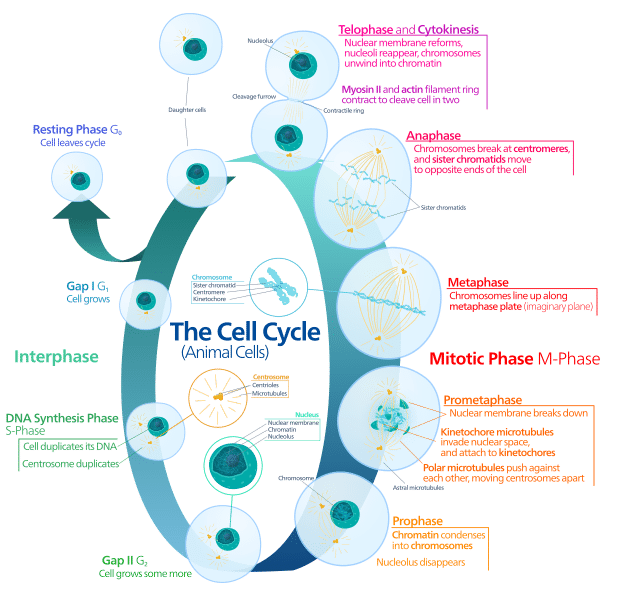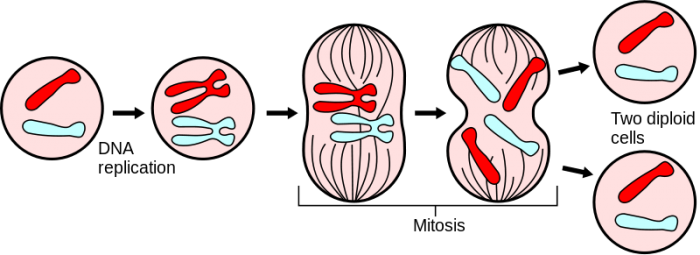
The difference between mitosis and meiosis is in the process by which each form daughter cells from a parent cell. Mitosis has one round of cellular division and genetic separation whereas meiosis has two rounds. The two processes are also different because in mitosis the daughter cells are exactly identical to the parent cells compared to meiosis where the daughter cells are not genetically identical to the parent cells.
Cells must be able to reproduce themselves to ensure the continued existence of the DNA that comprises them. To do this, cells use two different processes: Mitosis and Meiosis. Many people confuse the two processes because the two are similar in nature. Yet while Mitosis and Meiosis are similar, they also differ in several key aspects.
The short answer to the question of how mitosis and meiosis differ is that mitosis is the general process for how cells replicate themselves, creating two cells that are identical. By contrast, meiosis refers to the process by which sex cells, gametes, reproduce. In meiosis, the DNA from both the males and females of a species will be prepared to combine and create a brand-new DNA combination, passing parts of the old DNA onto the next generation.
While this is the difference between meiosis and mitosis, in a nutshell, the differences between the two can be very subtle and quite complex. This is why it is important to take a closer look at the differences between meiosis and mitosis.
The Process of Mitosis

Photo: Kelvinsong via Wikimedia Commons, Public Domain
Non-sex cells, like liver cells, blood cells, or skin cells, will reproduce themselves through mitosis. To do this they go through a process called the cell cycle. The cell cycle is responsible for doubling the genetic code and structures of a call and then dividing them into two different cells.
In general, the process that divides cells can be separated into four different phases: prophase, metaphase, anaphase, and telophase. Because prophase is so long, some scientists divide it into two phases: prophase and prometaphase. These four phases are responsible for organizing the genetic material, duplicating important cell organelles, and then dividing a cell into two different cells each with the required organelles and DNA.
In prophase, the cell begins to ready itself to divide, breaking down certain structures like the nucleolus, and creating other structures like the mitotic spindle. The nucleolus is part of the cell nucleus, and it is responsible for producing ribosomes. As the nucleolus breaks down, the mitotic spindles are created. The job of the mitotic spindle will be to organize the chromosomes and prepare them for a division. The mitotic spindle is formed between centrosomes. A centrosome is an organelle that helps organize chromosomes during mitosis.
The second half of prophase (a.k.a. prometaphase) has the mitotic spindle capturing the chromosomes in preparation to divide them. The chromosomes have compacted by now, so they are now very dense, and they are released into the cytoplasm of the cell when the nuclear envelope breaks down.
Metaphase has the chromosomes line up at the center of the cell. The chromosomes are attached to the centrosomes, which are now on opposite sides of the cell. The threads which make up the mitotic spindle connect the centrosomes to the chromosomes by attaching themselves to a part of the chromosome called the kinetochore. The cell will check to make sure that the sister chromatids (duplicated chromosomes) will separate evenly so that each of the “daughter cells” will get the right amount of chromosomes. If the sister chromatids will not divide evenly, the cell division process will be positive until the situation can be rectified.

Photo: Mysid via Wikimedia Commons, Public Domain
Anaphase is when the cell starts to divide everything. The sister chromatids will be pulled apart from one another towards opposite ends of the cell, which happens because the proteins that hold them together are broken down. The body of the cell will grow and lengthen, in preparation to divide into two cells.
During telophase, the cell is approaching the completion of division. In anticipation of division, it begins to reestablish all normal cell conditions. This means that the mitotic spindle is broken down into its component parts, and the nuclei are reformed. There should be one nucleus for each set of chromosomes. The nucleolus reappears as well, and the chromosomes unwind, returning to the regular uncompressed form.
Cytokinesis is the process by which the cytoplasm divides and completes the creation of two separate cells. Cytokinesis may begin in either anaphase or telophase, as different types of cells begin the process at different times. Cytokinesis will finish just after telophase does. Cytokinesis pinches one cell until it becomes two, at least in animal cells. Plant cells cannot do this because their cell wall makes them too rigid, so they simply create a new cell wall down the middle of the cell.
“A band of bacterial brothers
Swigging ATP with some others,
In a jocular fit,
They laughed till they split,
Now they’re all microbial mothers.” — Richard Cowen
The Meiosis Process
The four phases (prophase, metaphase, anaphase, and telophase) are present in both meiosis and mitosis. Yet what happens in them are different.
Because the function of meiosis is to divide chromosome numbers by half rather than simply copy existing chromosomes, it cannot just carry out the four phases that are involved in normal mitosis replication. Meiosis actually sees two divisions, known as Meiosis I and Meiosis II.
Meiosis I is very similar to mitosis, with the main difference being that between prophase and metaphase of Meiosis I the pairs of homologous chromosomes randomly exchange their genetic information. This process is called crossing over. Instead of separating the sister chromatids like in anaphase of mitosis, the anaphase of Meiosis I keeps the chromatids together. This means that by the time telophase of Meiosis I ends, there are two cells with non-identical sister chromatids. These cells are haploid cells, meaning that they contain a single set of complete chromosomes.
Meiosis II sees the two new daughter cells, with their non-identical chromatids, divide once more. The haploid cells still have chromosomes that consist of two sister chromatids, though they only have one complete chromosome set. A key difference is that when the homologous chromosome pairs orient themselves for division, they do so randomly. After the second round of division in Telophase II, the four haploid cells that result will have non-duplicated chromosomes. These haploid cells will become sperm cells and egg cells.
Summing Up The Differences Between Meiosis and Mitosis
In summary, the primary differences between meiosis and mitosis are that meiosis divides cells twice, produces four (non-identical) haploid cells instead of two (identical) diploid cells, creates genetic variation via crossing over, aligns chromatids randomly during metaphase, and does not divide sister chromatids in anaphase of meiosis I.
Meiosis essentially takes the system of division that occurs in mitosis and modifies it to ensure that four haploid cells are created, each with half the number of chromosomes from the parent. These haploid cells are ready to combine with the cells from a partner and form an embryo, which will grow and continue the process once more.









